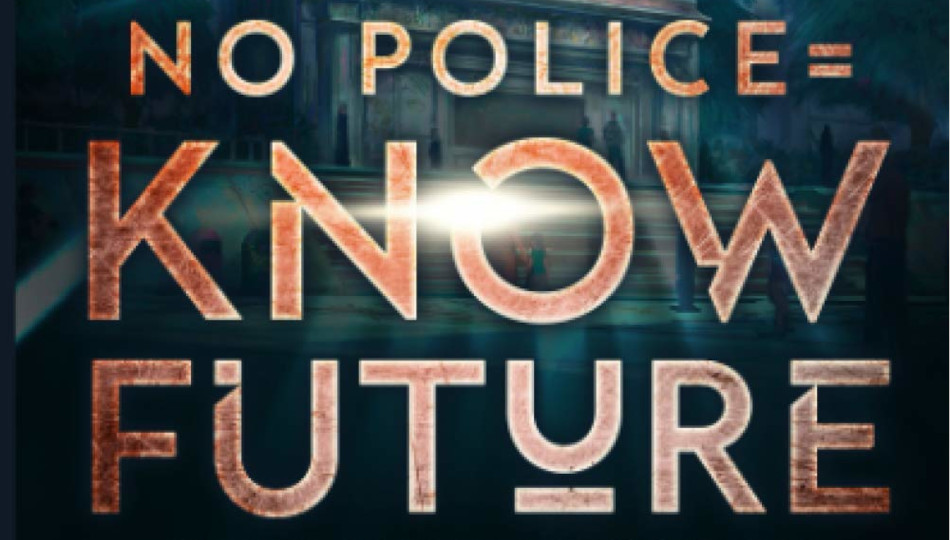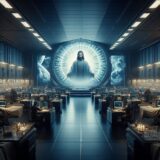
We are now less than two full years from the future envisioned by Ridley Scott—and partially by Philip K. Dick—in the movie Blade Runner. That movie came out 35 years ago, in 1982; though it was being worked on, obviously, for at least a year prior. Notable events of 1981 include Ronald Reagan taking office—ending the Iranian hostage incident—the launches of the STS-1 (Columbia) and STS-2 (also Columbia) space shuttles; Simon & Garfunkel’s Concert in Central Park; the death of Bob Marley; the kidnapping and death of John Walsh’s son Adam (prompting the TV show America’s Most Wanted); and the 39th World Science Fiction Convention, Denvention II, in Denver, CO.
One reason I mentioned Denvention was that I was there; among the exhibits in the Art Show was a full-sized Spinner (Figure 1) from Blade Runner, and a typical 2019 apartment scene (possibly Rick Deckard’s) with props from the upcoming movie. I wish I had looked more closely, but I didn’t. (Also in attendance, though I didn’t notice, were actors Mark Hamill and Carrie Fisher from the upcoming movie Star Wars, or so I’m told.)
I’m not sure what prompted Scott’s decision to film what was an extremely dystopian—and typically Dickian—novel about the future and set it only 38 years (from release) ahead. It has been some years since I’ve read Do Androids Dream of Electric Sheep?, the novel on which Scott based the movie, so I don’t remember if that was in the book. In my opinion, then, by doing that, Scott took the film firmly out of the science-fiction (i.e., predictive) world and more into the philosophical, morality tale world.
I’m assuming that, since you’re reading this, you’ve seen Blade Runner—the original, starring Harrison Ford, Sean Young, Rutger Hauer and all the rest—and have either seen or are thinking of seeing Blade Runner 2049, set only 30 years after the original setting. The original—using a gritty, multicultural, overcrowded Los Angeles of the future, where almost all animals were extinct (and being “replicated” as android versions, exactly as the humans were) brought into question the nature of humanity; the reasons we strive to keep going even in the face of almost-certain death; and various other concepts and moral precepts.
The Nexus-6 replicants—Zhora, Pris, Leon, Roy—who knew that they had a designed-in limited life span, but who came to Earth from the offworld colonies in an ulitimately futile attempt to lengthen that lifespan—did horrendous things to others but justified it to themselves in that attempt. But when told by Eldon Tyrell, their designer, that “the candle that burns twice as brightly burns half as long,” Roy Batty (Rutger Hauer) killed his “father,” Tyrell, the man who made Roy the virtual superman that he was, compared to humans.
Depending on which version you’ve seen—I have a Blu-Ray with five discs and several versions—you may or may not have heard Rick Deckard’s (Harrison Ford) voice-over soliloquy as he and Rachael (Sean Young) escaped Los Angeles in Deckard’s spinner. In the voice-over, he mused over whether Rachael—who we knew shortly after meeting her was a replicant, but who didn’t herself know—had a limited lifespan. At that point, Deckard didn’t know that he was a replicant. (Ridley Scott himself has confirmed that on several occasions.) Audiences responded to Deckard’s world-weariness, his desire to stop “retiring” (killing) replicants and his attempt to escape the overcrowded future megalopolis that was LA.

In contrast, Ryan Gosling’s blade runner persona is neither worldly nor weary. In stark opposition to Deckard, “K” (as he is called—his real cognomen is KD9-3.7), even while he’s fighting for his life, seems to be disconnected from the real world. His standard expression is a bland and somewhat blank stare; he has the same expression when reporting to his superior officer Lt. Joshi (Robin Wright) as when he tells Sapper Morton (Dave Bautista) he’d rather apprehend him than the alternative (“retire” him). His disconnect from reality is complete: his girlfriend Joi (Ana de Armas), is an AI without an actual body. For a present, he buys her a memory stick/virtual projector so that she can leave the apartment they inhabit and go with him (still as only a projection, however).
So here’s the story: during the last 30 years (screen time), there were ecological disasters; thanks to wholesale revolts—by Nexus 8s, one guesses—Tyrell Corp. went bankrupt. The world was saved from starvation by Niander Wallace (Jared Leto) who—it says in an IMDB synopsis, ‘cause I missed it somehow—is blind. Wallace has bought the remnants of the Tyrell Corp. and now makes new-model Nexuses that “obey.”
However, there are many Nexus 8s—with open-ended lifelines—that have made their way to Earth, and they are being retired by blade runners. (Here’s one of the moral/philosophical questions: Sapper Morton (Dave Bautista) is living quietly in the farmlands, by himself, and raising protein crops [specially-designed grubworms of some kind] to benefit mankind. So why hunt him down and target him for retirement?)
But when K does retire him, the detachable drone on top of K’s spinner finds a box buried several meters under a dead tree (and wood is apparently very expensive in this future) in the “farm”yard. The box is excavated, and it contains a full set of bones—of an adult female who apparently died in childbirth. Surprise! She was a replicant!

The movie switches from K trying to retire Nexus 8s to trying to find out whether the bones belonged to Rachael and, if so, where’s Deckard and where is the child? As you can probably surmise, Deckard is alive; and there is a meeting—this is hardly a spoiler—between him and K. There’s also a subplot here of K trying to find out whether a memory he possesses is real or implanted. Since K knows he’s a replicant—and never was a child—how could he have a memory of being chased, as a child, by other children who wanted to own a crudely-carved wooden horse he possessed?
Just as Ford’s moodiness, weariness and apparent sense of fatality served the original film well, I think Gosling’s detachment works in this movie. As you, the viewer, are drawn into the puzzle, Gosling seems to stay apart from the action emotionally. Ford’s Deckard was focused on finding and retiring the Nexus Sixers—who all seemed to have physical advantages over Ford, but who fell, one by one, to his gun. He became obsessed with Rachael and her memories, but seldom seemed to question his own.
Gosling’s “K” seemed to have no emotional stake—but since he was able to physically restrain the more advanced Nexus-8 Sapper Morton, who was much larger than he, one guesses that, like Deckard, he is even more advanced than the model he is retiring. He becomes emotionally involved—at least to some degree–when he questions his own memories.
I won’t go any farther with the plotline here, as we’re dallying with spoilers, and I could slip up and drop a hint you don’t want me to drop, just so you can have the fun of evaluating the movie all on your own. In my opinion, though, it’s not “noir” as the original was, but it captures the feel of the original in that it is obviously a continuation—I’m not sure I’d call it a sequel.
I have read a number of reviews of this movie, and it appears you either love it or hate it; there seems to be little middle ground. My wife, who is a giant Blade Runner fan (the original) really, really liked it. Because it was two and three-quarters hours long, I was afraid it would drag—and because I’m a male of a “certain age” I tend to have to visit the washroom occasionally during long movies—but it never did drag, in my opinion. The sets and CG—including the 3D; some of the shots through windows and water, especially–used 3D well; the sets and props were well done. The updated spinners worked, too. Some of the holographic effects were exceptional.
The props and miniatures were also excellent; even when the spinners were flying up into a darkened Tyrell Corp.—a very nice nod to the first movie—there was no sense of miniature work. (My touchstone for seamless miniature work is Aliens, where they were flying from the Sulaco down to the colony; all of that looked and felt real.) There were a number of nods to the original, including one to Pris (Darryl Hannah—who doesn’t appear in this movie); I won’t say any more, as you will probably enjoy finding them yourself.
As I said earlier, Gosling’s detachment works in context here (I’ve seen some reviews decrying his acting in this movie); and I think all the actors have done a very good job. We will probably see this again in the theatre while we can—but we’ll bring earplugs! (See the next couple of paragraphs….)
Also, I’ve seen a number of people complain about the soundtrack—why, they wonder, didn’t they get Vangelis to do a new soundtrack? Only Denis Villeneuve, the director, knows that. Although he does use one Vangelis cut from the original, the rest of the soundtrack (by Hans Zimmer and Benjamin Wallfisch) with the exception of a few 20th-century cuts (Frank Sinatra’s “Summer Wind,” some Elvis, a bit of Peter and the Wolf and so on) is an attempt to “sound like” Vangelis.
For some of it, there was the right kind of synthesized music, “nearly” Vangelis… and for some of it, there was extremely obtrusive and loud electronic “noise” that didn’t work (my wife, the Beautiful and Talented Lynne Taylor Fahnestalk, called it “exploding music”) for us. Overall, the musical background part of the soundtrack was too loud, in my opinion.
And here’s the part I dread—it seems all too possible that Villeneuve is setting us up for a sequel. I can’t detail why—because that might involve spoilers—but I think that if he (or yet another director) does do one, it will be one too many. Yet the possibility is there.
If you feel like it, please comment on this column. You can comment here, or in Facebook, on my page, or in the several Facebook groups where I link every week. I welcome all comments. Don’t feel you have to agree with me to post a comment, either. We learn more from those who disagree sometimes than we do from those who agree with us. My opinion is, as always, my own, and doesn’t necessarily reflect the views of Amazing Stories or its owners, editors, publishers or other columnists. See you next week!










